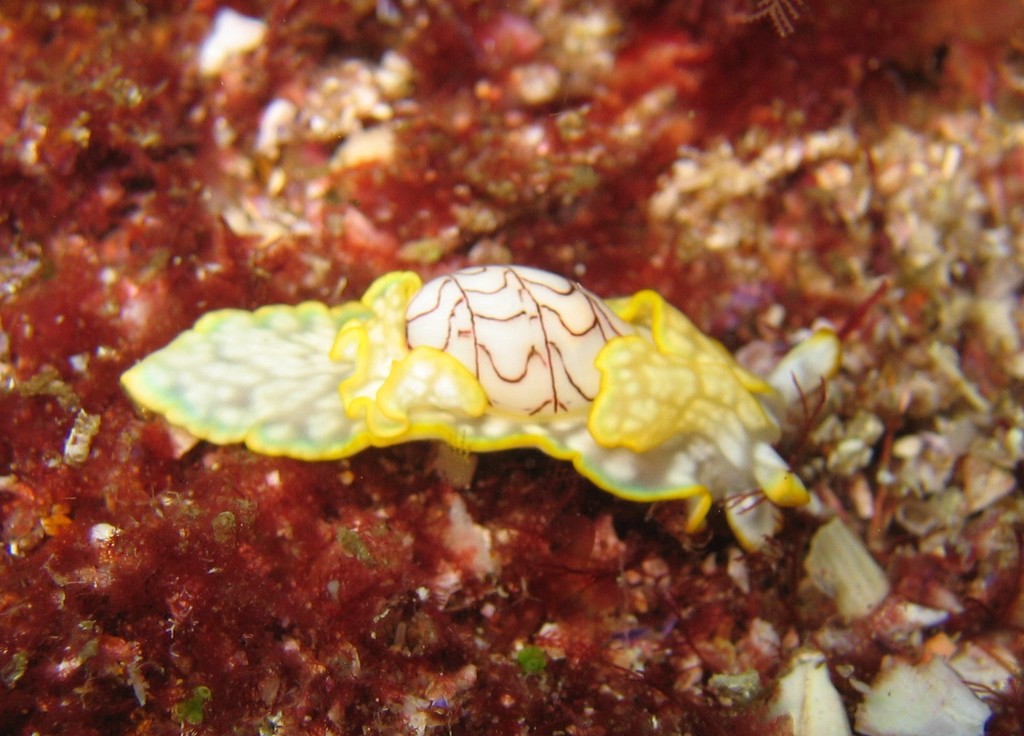- Aplustridae
image_size = 225px
image_caption = "Micromelo guamensis"
regnum =Animal ia
phylum =Mollusca
classis =Gastropoda
subclassis =Orthogastropoda
superordo =Heterobranchia
ordo =Opisthobranchia
subordo =Cephalaspidea
superfamilia =Acteonoidea
familia = Aplustridae
familia_authority = Gray, 1847
subdivision_ranks = Genera
subdivision = See text.The Aplustridae are a
taxonomic family of seasnail s, marineopisthobranch gastropod mollusk s in the orderCephalaspidea , the headshield slugs. Its former name Hydatinidae (Pilsbry, 1893) has been declared invalid. [ ^Bouchet, P.; Rocroi, J.-P. (Ed.); Frýda,J.; Hausdorf,B.; Ponder, W.; Valdes, A.; Warén, A. (2005). Classification and nomenclator of gastropod families. Malacologia: International Journal of Malacology, 47(1-2). ConchBooks: Hackenheim, Germany. ISBN 3-925919-72-4. 397 pp ]Description
The soft parts of animals in this family are brightly colored.
The oval bubble-shaped shell is thin and fragile and has a sunken spire. The shell is beige-colored with colored bands or stripes.
There is no operculum
Life habits
The soft parts of the animal cannot retract completely into the shell, and therefore these animals depend for their defense on swimming and camouflage. They are specialised feeders, eating cirratulinid
polychaete worm s.Genera and species within the family Aplustridae
Genus "Hydatina" Schumacher, 1817
*"Hydatina albocincta " Van der Hoeven, 1839 white-banded bubble, white-striped bubble, clown paper bubble (may be a synonym of "Hydatina zonata")
**Distribution: South Africa, Hawaii, Indo-West Pacific, Japan to Philippines; also recorded in New South Wales (Australia) and New Zealand.
**Length: 25-60 mm
**Description: very thin, fragile shell; wide white aperture; lip goes beyond the apex; smooth, thin columella; shell color is very variable, white or light brown to a deep red; the shell has four broad brown spiral bands; not as common as Hydatina physis.
*"Hydatina amplustre " Linnaeus, 1758 royal paper bubble, ship’s flag shell, swollen bubble.
**Distribution: tropical Indo-Pacific, Australia, South Africa to Hawaii, Madagascar.
**Length: 1.5–4 cm
**Description: active at night, it lives in shallow water on reefs, with a mix of sand, rock and tuf algae; predator feeding on polychaete worms; smaller and more heavily calcified shell than the other members of this species; shell with horizontal lines, with lightbrown stripes, outlined in black, alternating with translucent white stripes; the animal is too large to fit inside its shell. Empty shells are used by hermit crabs.
*"Hydatina cinctoria " Perry, 1811 (color variant and synonym of "Hydatina zonata").
**Distribution: South Africa
*"Hydatina exquisita " Voskuil, 1995
**Distribution: Marquesas Islands
**Length: 21 mm
**Description: very globose, thin shell with black and purplish spiral bands on body whorl and a narrow white band below the suture and at anterior end: anterior end of the columella is directed slightly to the right.
*"Hydatina montilai " Delsaerdt, 1996
**Distribution: Philippines.
*"Hydatina physis " (Linnaeus, 1758) cute hydatina, striped paper bubble, green-lined paper bubble, brown-lined paper bubble, rose petal bubble shell
**Distribution: circumglobal in tropical waters, Red Sea, South Africa, West Africa, Arabian Sea, Maldives, Philippines to Hawaii, Australia, New Zealand, Canary Islands, Lusitanic area (Europe)
**Length: 2–6 cm
**Description: lives in shallow water; crawling and burrowing into the sand; feeds on polychaete worms of the family Cirratulidae, mussels and slugs; its color can vary from very dark to a pale pinkish white; thin, globose and fragile shell with an umbo; last whorl covers the rest; a translucent white shell with transverse brown lines; no operculum; large foot, with lateral parapodia (fleshy winglike flaps); the large body cannot be fully retracted into its shell; well-developed sensory mechanisms; the egg mass is gathered on the mantle before being attached to the sand by a mucous thread.
*"Hydatina velum " Gmelin, 1791 (probably color variant and synonym of "Hydatina zonata")
**Distribution: Indian Ocean, East Africa
**Length: 25–50 mm
*"Hydatina vesicaria " (Lightfoot, 1786) brown-lined paper bubble
**Distribution: Florida, Mexico, Caribbean.
**Length: 17–45 mm
**Description: lives on the bottom at the depth of 8 m to 64 m; very fragile and delicate shell with fine brown spiral lines
*"Hydatina zonata " Solander in Lightfoot, 1786 zoned paper bubble
**Distribution: Indo-Pacific.
**Length: 40 mm
**Description: the shell has the same shape as "Hydatina physis"; characterised by thin thick irregular brown lines running across the translucent white shell, essentially parallel to the outer lip of the shell. There are colorless spiral bands around the base and apex of the shell. The color of the animal varies from a pale translucent almost white form to a dark pinkish brown edged with white.Genus "Micromelo" Pilsbry, 1895
*"Micromelo guamensis " Quoy & Gaimard, 1825 Guam paper bubble
**Distribution: South Africa, Japan, West-Australia.
**Length: 10-12 mm
**Description: white shell with black to brownish wavy longitudinal bands; may be the same species as "Micromelo undatus", but is considered an Indo-West Pacific species; found in shallow water, crawling on algae-covered rocks; green mantle with white spots and yellowish margins; the shell is too small to hold the whole body.
*"Micromelo undata " (Bruguière, 1792) miniature melo
**Distribution: Caribbean, Florida, Costa Rica, Panama, Bermuda, Brazil, Cape Verde Islands, Canaries, Ascension Island, Eastern Atlantic, South Africa to Japan and Hawaii
**Length: 12-17 mm
**Description: not a common species; lives in shallow water up to 5 m on soft substrates and the algal turf areas of rocky reefs; the thinly calcified shell is covered with undulating brown lines, crossed with two other spiral lines; the margin of the foot has a diffuse blue line;. Large, colorful body is blue with white spots; feeds on cirratulinid worms, whose toxins they incorporate for their defense.Genus "Parvaplustrum" Powell, 1981
*"Parvaplustrum tenerum " Powell, 1951
**Distribution: Argentina, Falkland Islands, subantarctic
**Length: 2.8 mmNotes
References
* Rudman, W.B. (1972) "The anatomy of the opisthobranch genus Hydatina and the functioning of the mantle cavity and the alimentary canal". "Zoological Journal of the Linnean Society" 51(2): 121-139
* Guangyu, 1997. Fauna Sinica Phylum Mollusca Class Gastropoda Subclass Opisthobranchia Order Cephalaspidea. 225pp., 28pls. (3col.pls.), 35 figs
* Powell A W B, "New Zealand Mollusca", William Collins Publishers Ltd, Auckland, New Zealand1979 ISBN 0-00-216906-1
Wikimedia Foundation. 2010.

